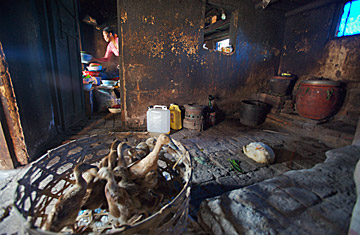
CLOSE QUARTERS: Fowl are kept in the kitchen of a family home in the Balinese village of Munduk Juwet as they await sacrifice in a Hindu ceremony marking six months of an infant's life
(2 of 3)
I have reported on bird flu since the disease burst out of southern China in 2003, most of that time with scientists dissecting the virus in secure labs, and I had always assumed that animal-disease control would be the easy part. But in the villages of Indonesia, riding shotgun with overworked government vets and international experts through this nation of 234 million people and 1.3 billion poultry, I have come to understand the challenge is far more complex. Says Christine Jost of the Nairobi-based International Livestock Research Institute (ILRI): "Avian influenza isn't just a problem on its own, but a symptom of Indonesia's broader problems," like persistent poverty, substandard education, a vast and broken geography, and weak central authority. Indonesian officials are quick to point out the barrage of more immediate disasters they have endured since bird flu began: the tsunami, deadly earthquakes, even a mud-spewing volcano. But quakes and eruptions can't be stopped—bird flu can.
Epidemiology, the study of the distribution of disease, comes down to numbers—the larger and denser a host population, the faster a pathogen can spread. The number of chickens in Indonesia has exploded, thanks to what's called the Livestock Revolution—the rapid growth in domestic animal production and consumption in the developing world. The whirlwind industrialization that brought Western ways of life to developing countries—think skyscrapers, cell phones, flat-screen TVs and air pollution—also remade the way people eat. As the cheapest step on the livestock ladder, poultry production naturally multiplied—especially in Muslim-majority Indonesia, where pig raising is rare. That paved the way for the rapid spread of H5N1. "In the early 1980s, around three times as much meat was consumed in developed countries versus developing ones," says Christopher Delgado, an agricultural economist with the World Bank. "Today that's virtually reversed. It's a huge change, and it's propelled by hundreds of millions consuming meat for the first time."
In the West, as demand for meat rose, poultry production shifted to large-scale commercial factories that could churn out birds. Indonesia also boasts modern poultry farms, but a comparatively large number of birds can still be found wandering village backyards. While the big poultry producers appear to have mostly controlled their outbreaks—the contained nature of commercial farms means that bird flu can be more easily stamped out and prevented—the virus has spread to backyard poultry, where it's much harder, perhaps impossible, to end the disease. Worse, people live cheek by beak with village chickens, so H5N1 can more easily pass from infected birds to unlucky humans.
The solution would seem obvious: move poultry into secure commercial farms and cull the ones that remain. But chickens—which were likely first domesticated by humans on Java—are an inseparable part of daily life for Indonesians, in a way that must be witnessed to be understood. Birds are used for religious rituals, such as the Hindu cremation ceremony on the Indonesian island of Bali, where a chicken is kept present as a magnet for any evil spirits. Backyard poultry is also an invaluable source of protein for poor villagers who might not otherwise have easy access to meat. Even many urban Indonesians prefer the taste of free-range chickens over factory-farmed birds, and will pay a premium for them—as you can see at one of Jakarta's wet markets, where live birds are killed, cleaned and delivered to consumers. And chickens are walking bank accounts—backyard birds can be kept for virtually nothing, since they forage for their own food, but can be sold off when extra income for school fees or medicine might be needed. They're even beloved pets, though bird flu appears to have complicated the relationship. "We keep chickens not just for money, but to reduce stress," says Hadiat, a farmer in Kaseman village in West Java. "But now with the flu, they stress us out."
The fact that poultry is so intertwined with Indonesian life may explain why the country was so slow to respond to bird flu during the first two years of outbreaks. While Thailand eventually reacted to H5N1 with a severe culling program—killing all birds within 5 km of new outbreaks—and Vietnam tried mass bird vaccination and market closures, Indonesian officials all but ignored the threat. "It seemed like the Ministry of Agriculture (MOA) was not fighting the same fight we were," says Juan Lubroth, senior animal-health officer at the U.N. Food and Agriculture Organization (FAO). It wasn't until the disease began to pass to human beings in the summer of 2005 that Jakarta woke up and began to address bird flu, but by then H5N1 had established an unbreakable hold on free-range birds throughout the country. Says Peter Roeder, an FAO animal-health officer who has worked in Indonesia: "There were infections through wide swathes of the country."
Even Indonesia's harshest critics have to acknowledge, however, just how little health officials in Jakarta had to work with. In the mid-1990s, Indonesia's veterinary sector was strong enough to stamp out a national outbreak of foot-and-mouth disease—not a simple task. But then came 1997's financial crisis, followed by the virtual collapse of central government authority after the ouster of longtime dictator Suharto in 1998, which shifted much governmental power to Indonesia's 440 districts. "A provincial governor can call a district to get something done on bird flu, and if the district head doesn't agree, nothing will happen," says one Jakarta-based Western expert who works on local bird-flu control programs. And while Indonesia has budgeted nearly $60 million for bird flu in 2007, up 9% from the year before, "it's still not enough to control the disease," says Elly Sawitri, who heads the MOA's bird-flu crisis-management unit (CMU).